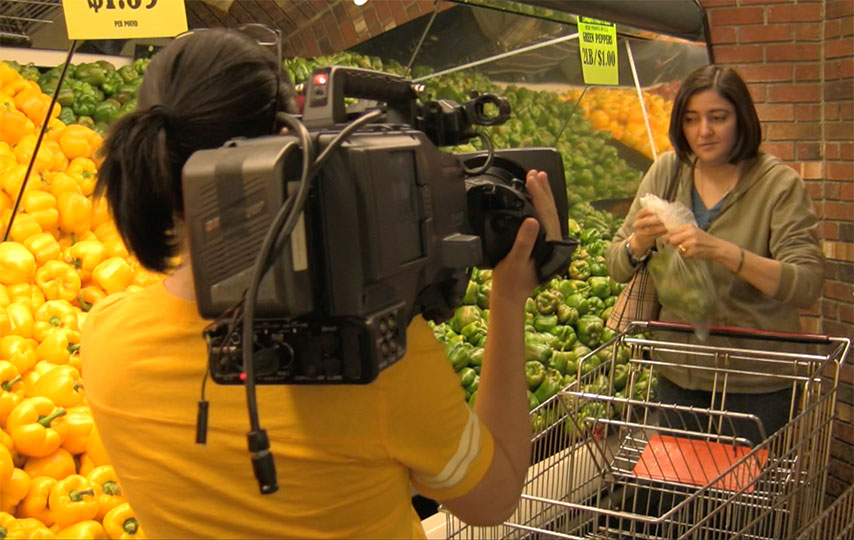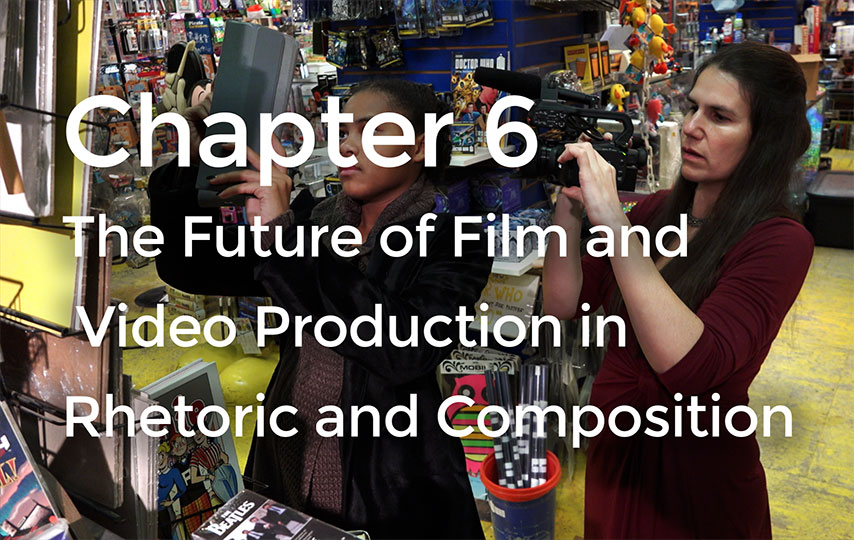by Alexandra Hidalgo
my dissertation chair and mentor and the first person
in Rhetoric and Composition to teach in a computer
classroom. Pat has helped create feminist and digital
scholarship for almost four decades. This video book
is a tiny piece of her pedagogical and scholarly legacy.
Introduction
At some point in November 2015 I became a footage junkie. We didn’t have a single visitor in our home who wasn’t asked to let me film them or to film me and/or my husband filming. The moment they walked out the door, I was editing the new footage, and by the time I got to bed that night, my mind would start its half-desperate, half-transcendent search for more images to capture. I’d been filming for this video book since the previous March, when I decided to turn a playful lens to the Conference on College Composition and Communication. Through spring, summer, and fall I filmed from time to time, uploading the footage to an ever-growing Final Cut Pro library.
I was sure that I had more than enough footage that November when I started creating the mediated versions of the video book you’re about to see. And yet, within a week I’d gone through half the footage I’d been gathering for months. I spent a restless night wondering how I would ever be able to finish a project that required such a vast amount of footage, then remembered how much I like capturing the world through my beloved XA-20 HD-Pro camera. For over two months, through holiday gatherings and heavy winter storms, I filmed every day. I have five years of experience as a documentary filmmaker but nothing taught me more about life behind the camera than these fevered, rushed, ecstatic weeks when there was never enough footage to fill the six chapters that comprise this video book.
Although most of the images were created by me, there are a number of people whose aesthetic vision is an integral part of the video book. I feature the work of dozens of rhetoricians and filmmakers throughout the chapters, weaving a visual tapestry through their images to help give viewers a sense of how these groups are representing their ideas through film and video. There are also images of me behind-the-camera, most of which were filmed by my husband Nathaniel Bowler, Michigan State University undergraduate student Lindsey Spitzley, and my friend Jefferey Ivey. The behind-the-scenes footage of the making of my feature documentary Vanishing Borders was primarily filmed by Michelle Mueller. You will not only see but also hear my narration accompanied by a soundtrack. While I recorded all the narration on my own, Michigan State undergraduate student Sarah Shaw shared the profound weight of editing the sound with me. I also collaborated with Michigan State undergraduate Shell Little in creating the website you’re currently visiting. She used her remarkable coding skills to make sure the site is easy to navigate and accessible. Without their tireless collaboration, there would be no video book.
Back in 2014 when I started toying with the idea of launching into this project, I took to YouTube to find images of women filming that I could use to illustrate the principles of feminist filmmaking I discuss here. I was shocked by how little footage of women behind the camera could be found among its seemingly infinite videos. When I started working on the video book, I set out to fill that void by filming women and girls camera-in-hand, as well as editing footage. I hope that by the time you finish watching this video book, the idea that women know how to make films and that it is natural for them to do so will have seeped into your conscious and subconscious mind in the same way that images of men behind the camera have been there for as long as you’ve been consuming media.
Other visual themes you will see are children, toys, hands, journeys, and crowds. I show children and toys because learning to make films is a return to that place of wonder, confusion, and possibility that is childhood and because the best way to approach the camera and editing footage is to play—and to do so alone and with others. Hands are one of the key links between alphabetic writing, which is one of the focal areas of research for Rhetoric and Composition, and filmmaking. Both practices require that we use our hands and an instrument in order to create something that relays a message. I aim to make that connection clear here. I also use footage of forward motion through feet and wheels to represent the long process that is making a film or video, but also the ways in which filmmaking comes with a sense of adventure and exploration. The last prevalent theme is crowds. At conferences, in cities, at universities, and in concerts, I show crowds to highlight the collaborative way in which films and videos are made, as well as moving images’ ability to reach and engage populations outside academia.
There are various ways to watch this video book. You can watch every chapter in the order in which they are presented. The chapters build on each other, so watching them in sequence is a good strategy. Here is what they cover:
Chapter 1 defines the video book’s key terminology and introduces viewers to the qualitative study I draw from as I make my arguments about film and video production in Rhetoric and Composition.
Chapter 2 uses my filmmaking experience and interviews with women filmmakers to define feminist filmmaking through six key principles.
Chapter 3 provides a taxonomy of the film and video work currently done by rhetoricians.
Chapter 4 explores the ways in which rhetoricians use the principles of feminist filmmaking to learn how to make moving images and provides a set of guidelines for Rhetoric and Composition’s film and video production.
Chapter 5 uses the principles of feminist filmmaking to provide strategies for making film and video production count toward tenure and promotion.
Chapter 6 discusses the particular benefits that rhetoricians bring to academic film and video production and presents my thoughts on the future of moving images in Rhetoric and Composition.
While some viewers will watch every chapter, others will only watch the chapters that directly intersect with their interests. Feminist filmmakers and non-academics interested in their work will gravitate toward Chapter 2, while scholars producing non-moving-image digital texts will find ways to argue for the value of their work in Chapter 5. Burgeoning filmmakers in or outside academia will find much of use in Chapter 3. Those interested in memoir will find Chapters 1 and 6 more engaging, as that is where I discuss my own filmmaking journey at length.
No matter how you choose to engage with this video book, I hope that you enjoy the world we have crafted for you. In true feminist fashion, much of the writing was done while nursing my youngest son or holding him as he slept, and much of the footage was filmed with my two sons participating in the process. When I was a little girl, the show He-Man became a hit in Venezuela, where I was born. I didn’t much care for the muscle man and his cat, but TV executives decided to capitalize on his success by giving him a twin sister named She-Ra, who had her own show. As the studio heads predicted, little girls were much more interested in the brave warrior princess. During the course of each episode the animators would hide Loo-Kee, an elf-eared, squirrel-tailed character, in various scenes, and at the end they would ask viewers if they’d found him, showing us the places where they’d placed him. You’re welcome to play Loo-Kee’s game with my eldest son, William, who was an active and enthusiastic participant in most of the filming for this project, and who can be seen in many of the images, whether or not he’s the center of attention.
Whether you find William or not, I hope you’ll enjoy the feminist piece he helped me create and that you feel free to share, remix, and reimagine the ideas and images presented here.












